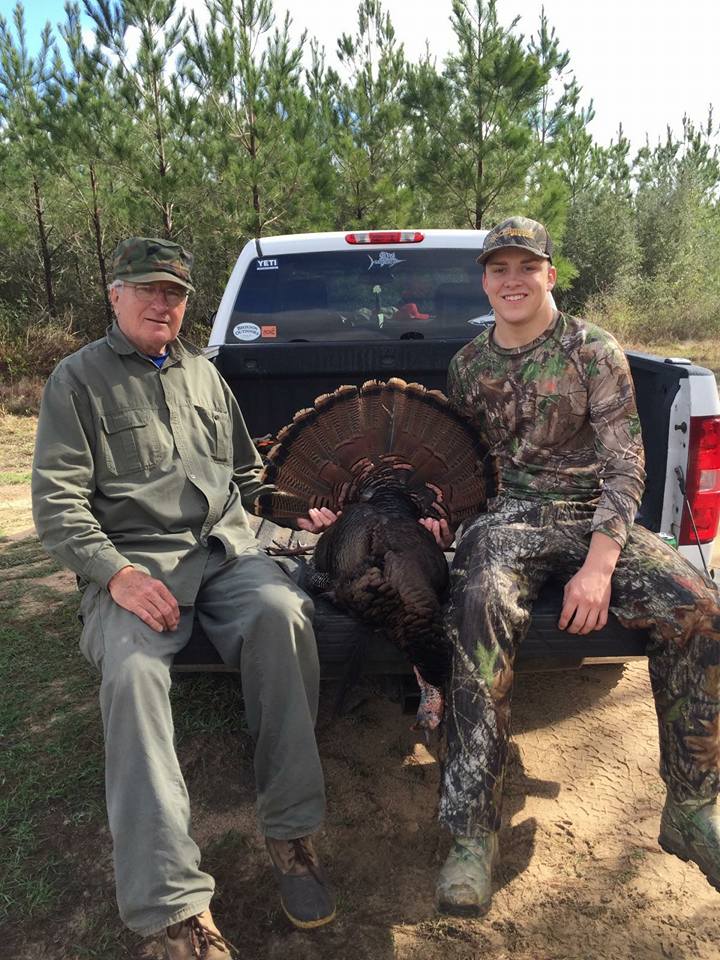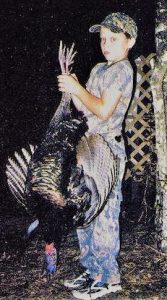
George Crain enjoyed teaching his grandson, Brady White, to hunt turkeys. (South Santa Rosa News file photo)
This spring, you can learn more about wild turkey abundance, distribution and the quality of available habitat where you plan to hunt by using updated resources from the Florida Fish and Wildlife Conservation Commission (FWC). We recently launched a new map that shows the predicted quality of habitat – good, fair or poor – based on the location, amount and arrangement of habitat needed throughout a wild turkey’s home range and life cycle.
This new information, based on a model developed for Virginia and adapted for Florida, is a powerful management tool. It allows FWC biologists to assess habitat suitability at the level of the wild turkey’s home range. This habitat assessment, combined with wild turkey sightings reported by the public during the 2020 Wild Turkey Summer Survey, enabled biologists to predict the distribution of wild turkeys across the state. This information is vital for helping FWC wild turkey biologists meet conservation objectives and provide sustainable hunting opportunities.
This new map is also valuable for wild turkey hunters who want more information about where they hunt or plan to hunt. You can drill down to an area smaller than two basketball courts to get a better understanding of habitat quality and the likelihood of wild turkeys occurring in a particular area. Because the habitat suitability model is unable to determine the condition of the understory, that layer of shrubs and small trees beneath the main forest canopy, the prediction may not be accurate in all areas, especially at smaller scales.
Find this new map at MyFWC.com/Turkey and click on “Wild Turkey Distribution Map.”
How to Hunt Wild Turkeys
Another resource new and experienced hunters can use is the online guide about how to hunt wild turkeys in Florida. This resource provides tips on what license and permits are required, where to hunt, what to wear, how to call wild turkeys, safety tips, and advice for creating healthy and delicious meals. Visit MyFWC.com/Turkey and click on “How to Hunt Wild Turkeys.”
Before heading afield, don’t forget to brush up on turkey hunting safety. Visit MyFWC.com/Turkey and click on “Tips for Safe and Successful Turkey Hunting.”
2021 Spring Turkey Season Dates
Spring turkey season south of State Road 70 opens March 6 and runs through April 11 on lands outside of the wildlife management area system. North of State Road 70, the season opens March 20 and runs through April 25.
Youth Turkey Hunt Weekends
If you’d like to take a youth turkey hunting, the FWC offers two Youth Spring Turkey Hunt Weekends: Feb. 27-28, south of State Road 70, and March 13-14, north of State Road 70. These Saturday-Sunday hunts are available to youth 15 years old and younger and occur on many WMAs and lands outside of the WMA system.
Brady White pictured at the age of 8 with his first gobbler that weighed 18 pounds 3 ounces and had a 10-inch beard
Learn more about this youth hunting opportunity and find a list of WMAs where a quota permit is not required at MyFWC.com/Turkey and click on “Youth Turkey Hunt Weekends.”
Turkey Hunting on Wildlife Management Areas
Many WMAs offering spring turkey hunting require a quota permit. However, there are WMAs that do not require a quota permit. You can find a list of WMAs that offer no quota permit spring turkey hunting by heading over to MyFWC.com/Turkey and clicking on “2021 Spring Turkey Hunt Guide.” You also can use the FWC’s online WMA Finder to locate public hunting opportunities. Use the various filters at WMA finder to search for areas based on species, season, location and more. Get started using WMA Finder by visiting MyFWC.com/WMABrochures.
We always recommend that before heading afield, you carefully review the WMA regulations brochure for the area you want to hunt because season dates and other rules may vary from statewide seasons and other WMAs. Also, before visiting a WMA, always check the area’s open/closed status to determine its availability to public access and if there are any road closures or updates about check stations or entrances. You can find this information by visiting MyFWC.com and clicking on the red button “WMA Open/Closed Status.”
Wild Turkey Season Regulations
For information about bag limits, methods of take, license and permit requirements and other regulations, visit MyFWC.com/Turkey and click on “2021 Spring Turkey Hunt Guide.”
Osceola and Eastern Wild Turkey
Florida has two subspecies of wild turkey — the eastern wild turkey and the Osceola or Florida wild turkey. The only place in the world the Osceola occurs is the Florida peninsula! Hunters interested in qualifying for the FWC or National Wild Turkey Federation’s respective wild turkey registry programs need to know the range of each subspecies. Any wild turkey harvested within or south of the counties of Dixie, Gilchrist, Alachua, Union, Bradford, Clay and Duval is considered to be an Osceola subspecies. See an Eastern/Osceola range map by visiting MyFWC.com/Turkey and clicking on “2021 Spring Turkey Hunt Guide.”
Wild Turkey Registry
If you harvest a wild turkey with an 11-inch beard or longer and spurs measuring at least 1.25 inches, you can apply for an “Outstanding Gobbler Certificate” and have your name listed in FWC’s Wild Turkey Registry.
Also, hunters under the age of 16 who have harvested their first gobbler can receive a “First Gobbler Certificate,” regardless of beard or spur measurements. Learn more about FWC’s Wild Turkey Registry by heading over to MyFWC.com/Turkey and clicking on “Wild Turkey Registry.”

































